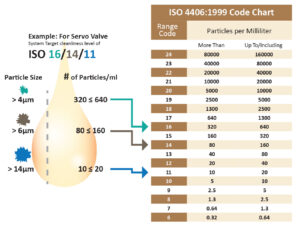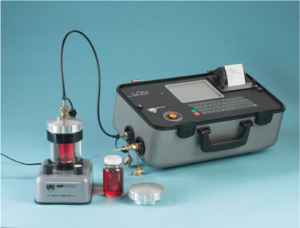
There are many methods to explain cleanliness level of hydraulic fluids in a system. Most known is given in the ISO standard ISO 4406. In this standard, a code number is allocated according to the number of particles per milliliter of fluid larger than 4, 6 and 14 micrometres. (µm) For example, for servo valve if the target level is 16/14/11, number of particles greater than 14 µm in 1 mL sample of fluid should be between 10 and 20.

There are different recommended levels for pumps, control valves and hydraulic motors. Contamination monitoring is carried out using automatic particle-counting devices which have to be calibrated using a sample of fluid with a known contamination profile. With perfect eyesight, adult human eye may be able to see particles only as small as 30 µm. For this reason, oil which looks clean may not be clean enough for hydraulic systems. Particles can block orifices, jam control valve spools or prevent closing of poppets in cartridge valves.
There are different ways of contamination entering during operation of hydraulic system:
The simplest type of filter used in hydraulic systems is suction strainers. They have coarse filtration capability and are usually assembled to pump suction line. Spin on filters are widely used in hydraulic systems with better filtration capability. They usually have a visual indicator to indicate when the filter element needs to be changed.
|
|
|
There may be different places for assembly of filters in hydraulic systems. It is necessary to analyse carefully where the contamination is most likely to enter into the system. System environment is also important. Main sections for assembly are suction line, pressure line and return line. Off-line filtration systems are also used with a seperate pump to draw fluid from oil tank, pass it through the filter and then return it back to oil tank.
Contamination monitoring can be done by taking a sample of fluid from the system and analyse it with a particle counter or with service in laboratory. Fluid sample can be get from drain line of the oil tank but it will not provide a true indication of fluid’s condition as much dirt will be in bottom of the tank. Sampling should be done from middle of oil tank with a valve and internal pipe. It is important to ensure the sample itself is not contaminated during sample process

Monitoring cleanliness level can also help to understand if there is any damage/wear on the components. Proper filtration is a critical factor for life of hydraulic systems.
Part of this article is from the book “An Introduction to Practical Hydraulic System Maintenance”
Images are used for training purpose only